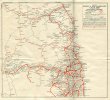androdas
Member
I did notice when I went through on the train yesterday how much Bedlington has progressed over easter from a hole in the ground to something resembling a station. Obviously a long way to go but that is all the platform edges now in place on the line so that is a good milestone. Hopefully not long to wait now for Bebside.






